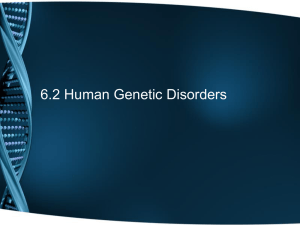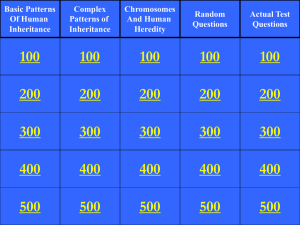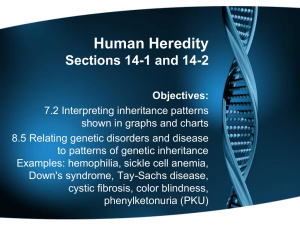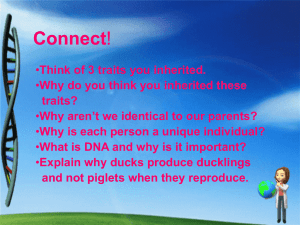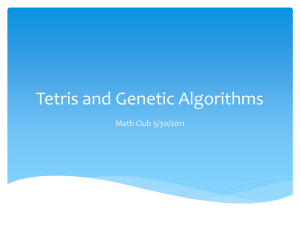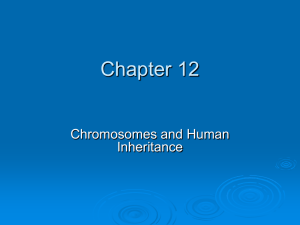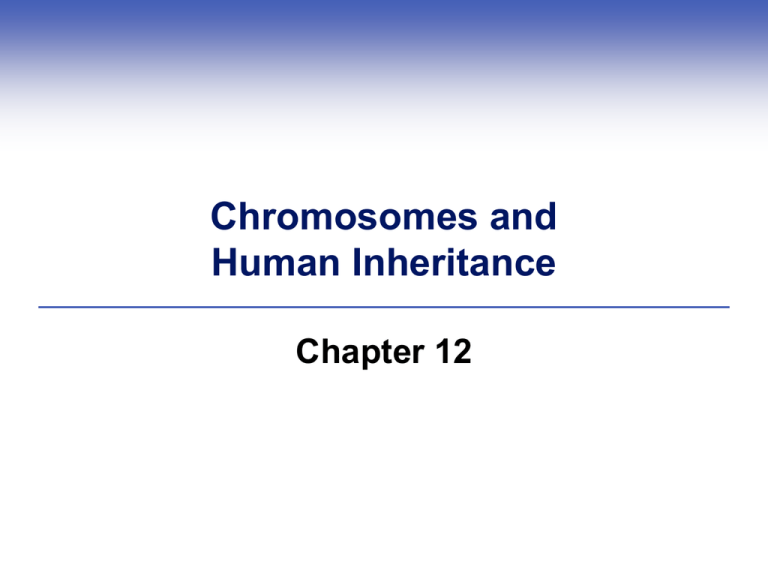
Chromosomes and
Human Inheritance
Chapter 12
Impacts, Issues:
Strange Genes, Tortured Minds
Exceptional creativity often accompanies
neurobiological disorders such as schizophrenia,
autism, chronic depression, and bipolar disorder
• Examples: Lincoln, Woolf, and Picasso
12.1 Human Chromosomes
In humans, two sex chromosomes are the
basis of sex – human males have XY sex
chromosomes, females have XX
All other human chromosomes are autosomes
– chromosomes that are the same in males and
females
Sex Determination in Humans
Sex of a child is determined by the father
• Eggs have an X chromosome; sperm have X or Y
Sex Determination in Humans
The SRY gene on the Y chromosome is the
master gene for male sex determination
• Triggers formation of testes, which produce the
male sex hormone (testosterone)
• Without testosterone, ovaries develop and
produce female sex hormones (estrogens)
Sexual Development in Humans
diploid
germ cells
in male
diploid
germ cells
in female
meiosis, gamete
formation in both
female and male:
eggs
sperm
X
×
Y
X
×
X
fertilization:
X
X
X
XX
XX
Y
XY
XY
sex chromosome combinations
possible in the new individual
Fig. 12-2a, p. 186
Fig. 12-2bc, p. 186
At seven weeks, appearance of
“uncommitted” duct system of
embryo
Y chromosome
present
At seven weeks, appearance
of structures that will give
rise to external genitalia
Y chromosome
absent
testes
Y chromosome
present
Y chromosome
absent
10 weeks
10 weeks
ovaries
ovary
penis
vaginal opening
uterus
penis
vagina
birth approaching
testis
b
c
Fig. 12-2bc, p. 186
Animation: Human sex determination
Karyotyping
Karyotype
• A micrograph of all metaphase chromosomes in a
cell, arranged in pairs by size, shape, and length
• Detects abnormal chromosome numbers and
some structural abnormalities
Construction of a karyotype
• Colchicine stops dividing cells at metaphase
• Chromosomes are separated, stained,
photographed, and digitally rearranged
Karyotyping
Fig. 12-3a, p. 187
Fig. 12-3b, p. 187
Animation: Karyotype preparation
12.1 Key Concepts
Autosomes and Sex Chromosomes
All animals have pairs of autosomes –
chromosomes that are identical in length, shape,
and which genes they carry
Sexually reproducing species also have a pair of
sex chromosomes; the members of this pair
differ between males and females
12.2 Autosomal Inheritance Patterns
Many human traits can be traced to autosomal
dominant or recessive alleles that are inherited
in Mendelian patterns
Some of those alleles cause genetic disorders
Autosomal Dominant Inheritance
A dominant autosomal allele is expressed in
homozygotes and heterozygotes
• Tends to appear in every generation
• With one homozygous recessive and one
heterozygous parent, children have a 50%
chance of inheriting and displaying the trait
• Examples: achondroplasia, Huntington’s disease
Autosomal Recessive Inheritance
Autosomal recessive alleles are expressed only
in homozygotes; heterozygotes are carriers and
do not have the trait
• A child of two carriers has a 25% chance of
expressing the trait
• Example: galactosemia
Autosomal Inheritance
Fig. 12-4a, p. 188
Fig. 12-4b, p. 188
Animation: Autosomal dominant
inheritance
Animation: Autosomal recessive
inheritance
Galactosemia
Neurobiological Disorders
Most neurobiological disorders do not follow
simple patterns of Mendelian inheritance
• Depression, schizophrenia, bipolar disorders
Multiple genes and environmental factors
contribute to NBDs
12.3 Too Young to be Old
Progeria
• Genetic disorder that results in accelerated aging
• Caused by spontaneous mutations in autosomes
12.2-12.3 Key Concepts
Autosomal Inheritance
Many genes on autosomes are expressed in
Mendelian patterns of simple dominance
Some dominant or recessive alleles result in
genetic disorders
12.4 Examples of X-Linked Inheritance
X chromosome alleles give rise to phenotypes
that reflect Mendelian patterns of inheritance
Mutated alleles on the X chromosome cause or
contribute to over 300 genetic disorders
X-Linked Inheritance Patterns
More males than females have X-linked
recessive genetic disorders
• Males have only one X chromosome and can
express a single recessive allele
• A female heterozygote has two X chromosomes
and may not show symptoms
Males transmit an X only to their daughters, not
to their sons
X-Linked Recessive Inheritance Patterns
Animation: X-linked inheritance
Some X-Linked Recessive Disorders
Hemophilia A
• Bleeding caused by lack of blood-clotting protein
Red-green color blindness
• Inability to distinguish certain colors caused by
altered photoreceptors in the eyes
Duchenne muscular dystrophy
• Degeneration of muscles caused by lack of the
structural protein dystrophin
Hemophilia A in Descendents
of Queen Victoria of England
Red-Green Color Blindness
Fig. 12-9a, p. 191
Fig. 12-9b, p. 191
Fig. 12-9c, p. 191
Fig. 12-9d, p. 191
12.4 Key Concepts
Sex-Linked Inheritance
Some traits are affected by genes on the X
chromosome
Inheritance patterns of such traits differ in males
and females
12.5 Heritable Changes
in Chromosome Structure
On rare occasions, a chromosome’s structure
changes; such changes are usually harmful or
lethal, rarely neutral or beneficial
A segment of a chromosome may be duplicated,
deleted, inverted, or translocated
Duplication
DNA sequences are repeated two or more
times; may be caused by unequal crossovers in
prophase I
normal
chromosome
one segment
repeated
p. 192
Deletion
Loss of some portion of a chromosome; usually
causes serious or lethal disorders
• Example: Cri-du-chat
segment C deleted
p. 192
Deletion: Cri-du-chat
Fig. 12-10a, p. 192
Fig. 12-10b, p. 192
Inversion
Part of the sequence of DNA becomes oriented
in the reverse direction, with no molecular loss
segments
G, H, I
become
inverted
p. 192
Translocation
Typically, two broken chromosomes exchange
parts (reciprocal translocation)
chromosome
nonhomologous
chromosome
reciprocal translocation
p. 192
Does Chromosome Structure Evolve?
Changes in chromosome structure can reduce
fertility in heterozygotes; but accumulation of
multiple changes in homozygotes may result in
new species
Certain duplications may allow one copy of a
gene to mutate while the other carries out its
original function
Differences Among
Closely Related Organisms
Humans have 23 pairs
of chromosomes;
chimpanzees, gorillas,
and orangutans have
24
• Two chromosomes
fused end-to-end
human chimpanzee gorilla
orangutan
Fig. 12-11, p. 193
Evolution of X and Y Chromosomes
from Homologous Autosomes
Ancestral reptiles Ancestral reptiles
(autosome pair)
Y X
Monotremes
Y X
Marsupials
Y X
Monkeys
Y X
Humans
Y X
areas
that can
cross over
SRY
A Before 350
mya, sex was
determined by
temperature, not
by chromosome
differences.
B SRY gene
evolves 350 mya.
Other mutations
accumulate and
the chromosomes
of the pair diverge.
areas that
cannot
cross over
C By 320–240 mya, the
two chromosomes have
diverged so much that
they no longer cross
over in one region. The
Y chromosome begins
to degenerate.
D Three more times, 170–130 mya,
the pair stops crossing over in
another region. Each time, more
changes accumulate, and the Y
chromosome gets shorter. Today, t
he pair crosses over only at a small
region near the ends.
Fig. 12-12, p. 193
12.6 Heritable Changes in
the Chromosome Number
Occasionally, new individuals end up with the
wrong chromosome number
• Consequences range from minor to lethal
Aneuploidy
• Too many or too few copies of one chromosome
Polyploidy
• Three or more copies of each chromosome
Nondisjunction
Changes in chromosome number can be caused
by nondisjunction, when a pair of
chromosomes fails to separate properly during
mitosis or meiosis
Affects the chromosome number at fertilization
• Monosomy (n-1 gamete)
• Trisomy (n+1 gamete)
Nondisjunction
Autosomal Change and Down Syndrome
Only trisomy 21 (Down syndrome) allows
survival to adulthood
• Characteristics include physical appearance,
mental impairment, and heart defects
Incidence of nondisjunction increases with
maternal age
Can be detected through prenatal diagnosis
Trisomy 21
n+1
n+1
n−1
n−1
chromosome
alignments at
metaphase I
NONDISJUNCTION alignments at
AT ANAPHASE I
metaphase II
CHROMOSOME
NUMBER
anaphase II IN GAMETES
Fig. 12-13b, p. 194
n+1
n+1
n−1
n−1
chromosome
alignments at
metaphase I
NONDISJUNCTION alignments at
AT ANAPHASE I
metaphase II
CHROMOSOME
NUMBER
anaphase II IN GAMETES
Stepped Art
Fig. 12-13b, p. 194
Down Syndrome and Maternal Age
Fig. 12-14a, p. 195
Fig. 12-14b, p. 195
Change in Sex Chromosome Number
Changes in sex chromosome number may
impair learning or motor skills, or be undetected
Female sex chromosome abnormalities
• Turner syndrome (XO)
• XXX syndrome (three or more X chromosomes)
Male sex chromosome abnormalities
• Klinefelter syndrome (XXY)
• XYY syndrome
Turner Syndrome
XO (one unpaired X
chromosome)
• Usually caused by
nondisjunction in the
father
• Results in females
with undeveloped
ovaries
12.5-12.6 Key Concepts: Changes in
Chromosome Structure or Number
On rare occasions, a chromosome may undergo
a large-scale, permanent change in its structure,
or the number of autosomes or sex
chromosomes may change
In humans, such changes usually result in a
genetic disorder
12.7 Human Genetic Analysis
Charting genetic connections with pedigrees
reveals inheritance patterns for certain alleles
Pedigree
• A standardized chart of genetic connections
• Used to determine the probability that future
offspring will be affected by a genetic abnormality
or disorder
Studying Inheritance in Humans
Genetic studies can
reveal inheritance
patterns or clues to
past events
• Example: A link
between a Y
chromosome and
Genghis Khan?
Defining Genetic Disorders
and Abnormalities
Genetic abnormality
• A rare or uncommon version of a trait; not
inherently life threatening
Genetic disorder
• An inherited condition that causes mild to severe
medical problems, characterized by a specific set
of symptoms (a syndrome)
Some Human Genetic Disorders
and Genetic Abnormalities
Stepped Art
Table 12-1, p. 196
Recurring Genetic Disorders
Mutations that cause genetic disorders are rare
and put their bearers at risk
Such mutations survive in populations for
several reasons
• Reintroduction by new mutations
• Recessive alleles are masked in heterozygotes
• Heterozygotes may have an advantage in a
specific environment
A Pedigree for Huntington’s Disease
A progressive degeneration of the nervous
system caused by an autosomal dominant allele
Constructing a Pedigree for Polydactyly
Animation: Pedigree diagrams
12.8 Prospects in Human Genetics
Genetic analysis can provide parents with
information about their future children
Genetic counseling
• Starts with parental genotypes, pedigrees, and
genetic testing for known disorders
• Information is used to predict the probability of
having a child with a genetic disorder
Prenatal Diagnosis
Tests done on an embryo or fetus before birth to
screen for sex or genetic problems
• Involves risks to mother and fetus
Three types of prenatal diagnosis
• Amniocentesis
• Chorionic villus sampling (CVS)
• Fetoscopy
Amniocentesis
Animation: Amniocentesis
Fetoscopy
Preimplantation Diagnosis
Used in in-vitro fertilization
• An undifferentiated cell is removed from the early
embryo and examined before implantation
After Preimplantation Diagnosis
When a severe problem is diagnosed, some
parents choose an induced abortion
In some cases, surgery, prescription drugs,
hormone replacement therapy, or dietary
controls can minimize or eliminate symptoms of
a genetic disorder
• Example: PKU can be managed with dietary
restrictions
Genetic Screening
Genetic screening (widespread, routine testing
for alleles associated with genetic disorders)
•
•
•
•
Provides information on reproductive risks
Identifies family members with a genetic disorder
Used to screen newborns for certain disorders
Used to estimate the prevalence of harmful
alleles in a population
12.7-12.8 Key Concepts
Human Genetic Analysis
Various analytical and diagnostic procedures
often reveal genetic disorders
What an individual, and society at large, should
do with the information raises ethical questions
Animation: Deletion
Animation: Duplication
Animation: Inversion
Animation: Morgan’s reciprocal crosses
Animation: Translocation
Video: Strange genes, richly tortured
minds

